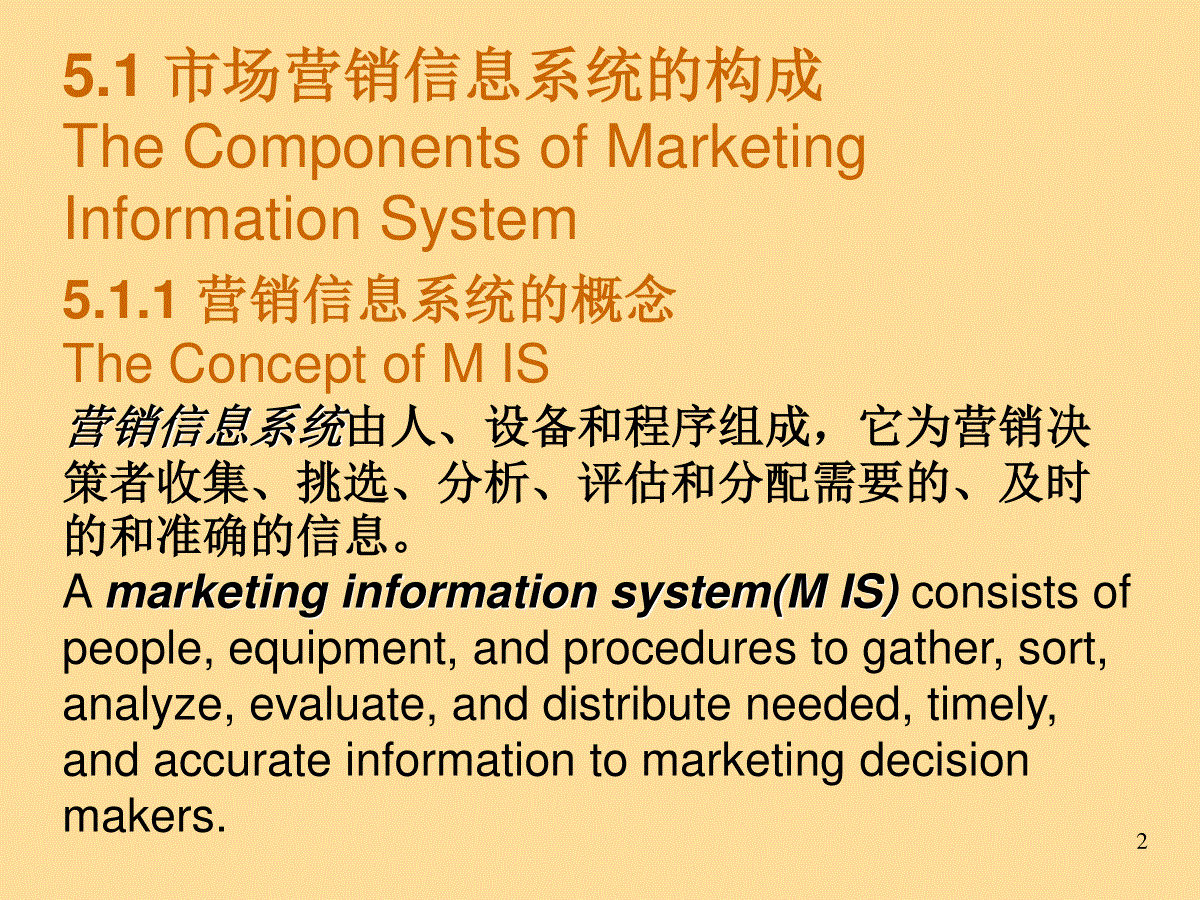当前位置:首页 > 商业/管理/HR > 市场营销 > Ch05_服装市场调研与预测
1Chapter5服装营销调研与预测MarketingResearchAndForecasting25.1市场营销信息系统的构成TheComponentsofMarketingInformationSystem5.1.1营销信息系统的概念TheConceptofMIS营销信息系统由人、设备和程序组成,它为营销决策者收集、挑选、分析、评估和分配需要的、及时的和准确的信息。Amarketinginformationsystem(MIS)consistsofpeople,equipment,andprocedurestogather,sort,analyze,evaluate,anddistributeneeded,timely,andaccurateinformationtomarketingdecisionmakers.3MarketingInformationSystemInformationAnalysisInternalDatabasesMarketingResearchMarketingIntelligenceDistributingInformationAssessingInformationNeedsMarketingManagersMarketingEnvironmentMarketingDecisionsandCommunicationsTheMarketingInformationSystemDevelopingInformation45.1.2营销信息系统的构成TheComponentsofMarketingInformationSystem营销决策支持系统MarketingDecisionSupportSystem营销调研系统MarketingResearchSystem营销情报系统MarketingIntelligenceSystem内部报告系统InternalRecordsSystem51.内部报告系统InternalRecordsSystem•订单—收款循环TheOrder-to-PaymentCycle(Wal-mart)•销售信息系统SalesInformationSystem5.1.2TheComponentsofMarketingInformationSystem62.营销情报系统MarketingIntelligenceSystem营销情报系统是使公司经理获得日常的关于营销环境发展的恰当信息的一整套程序和来源。Amarketingintelligencesystemisasetofproceduresandsourcesusedbymanagerstoobtaineverydayinformationaboutdevelopmentsinthemarketingenvironment.5.1.2TheComponentsofMarketingInformationSystem73.营销调研系统MarketingResearchSystem营销调研是系统的设计、收集、分析和提出数据资料以及提出公司所面临的特定营销状况有关的调查研究结果。Marketingresearchisthesystematicdesign,collection,analysis,andreportingofdataandfindingsrelevanttoaspecificmarketingsituationfacingthecompany.(营销调研步骤见7.2)5.1.2TheComponentsofMarketingInformationSystem84.营销决策支持系统MarketingDecisionSupportSystem营销决策支持系统是一个组织,它通过软件与硬件支持,协调数据收集、系统、工具和技术,解释企业内部和外部环境的有关信息,并把它转化为营销活动的基础。Amarketingdecisionsupportsystem(MDSS)isacoordinatedcollectionofdata,systems,tools,andtechniqueswithsupportingsoftwareandhardwarebywhichanorganizationgathersandinterpretsrelevantinformationfrombusinessandenvironmentandturnsitintoabasisformarketingaction.5.1.2TheComponentsofMarketingInformationSystem95.2营销调研的步骤TheMarketingResearchProcess确定问题和调研目标Definingtheproblemandresearchobjectives制定调研计划Developingtheresearchplanforcollectinginformation执行调研计划——收集和分析信息Implementingtheresearchplan--collectingandanalyzingthedata陈述研究发现Interpretingandreportingthefindings10Step1.确定问题和调研目标DefiningtheProblem&ResearchObjectives探测性调研ExploratoryResearch描述性调研DescriptiveResearch因果性调研CausalResearch•Testhypothesesaboutcause-and-effectrelationships.•Gatherspreliminaryinformationthatwillhelpdefinetheproblemandsuggesthypotheses.•Describesthingsasmarketpotentialforaproductorthedemographicsandconsumers’attitudes.11Step2.制定调研计划DeveloptheResearchPlan•Researchplandevelopmentfollowsthesesteps:–资料来源Datasources–调研方法Researchapproaches–调研工具Researchinstrument–抽样计划Samplingplan12(1)DeveloptheResearchPlan-DataSources资料来源GatheringSecondaryInformation二手资料InformationThatAlreadyExistsSomewhere.+ObtainedMoreQuickly,LowerCost.--MightNotbeUsableData.BothMustBe:相关的Relevant准确的Accurate及时的Current客观的Impartial一手资料InformationCollectedfortheSpecificPurposeatHand.13(2)DeveloptheResearchPlan-ResearchApproaches调研方法PlanningPrimaryDataCollection观察法ObservationalResearchGatheringdatabyobservingpeople,actionsandsituations(Exploratory)实验法ExperimentalResearchUsinggroupsofpeopletodeterminecause-and-effectrelationships(Causal)访问法SurveyResearchAskingindividualsaboutattitudes,preferencesorbuyingbehaviors(Descriptive)14PlanningPrimaryDataCollectionMailTelephonePersonalOnlineFlexibilityPoorGoodExcellentGoodQuantityofDataCollectedGoodFairExcellentGoodControlofInterviewerExcellentFairPoorFairControlofSampleFairExcellentFairPoorSpeedofDataCollectionPoorExcellentGoodExcellentResponseRateFairGoodGoodGoodCostGoodFairPoorExcellentContactMethods15(3)DeveloptheResearchPlan-ResearchInstruments调研工具问卷Questionnaires16(4)DeveloptheResearchPlan-SamplingPlans抽样计划PlanningPrimaryDataCollection抽样单位Whoistobesurveyed?(WhatSamplingUnit?)样本量Howmanyshouldbesurveyed?抽样程序Howshouldthesamplebechosen?抽样方法ProbabilityorNon-probabilitysampling?Sample-representativesegmentofthepopulation17收集信息CollectingtheData加工信息ProcessingtheData分析信息AnalyzingtheDataResearchPlanStep3.执行调研计划ImplementingtheResearchPlan18Step4.陈述研究发现InterpretingandReportingFindings调研者应提出对管理决策有用的重要发现。ResearcherShouldPresentImportantFindingsthatareUsefulintheMajorDecisionsFacedbyManagement.Step1.解释发现InterprettheFindingsStep2.得出结果DrawConclusionsStep3.向管理层报告ReporttoManagement195.3市场需求的测量与预测DemandMeasurementandForecasting•市场需求的测量ThemeasuresofMarketDemand•测量哪个市场?WhichMarkettoMeasure?•需求测量的有关词汇AVocabularyforDemandMeasurement•估计目前市场需求EstimatingCurrentDemand•估计未来需求EstimatingFutureDemand20市场需求的测量ThemeasuresofMarketDemand10%100%PotentialTotal05%10%20%40%100%PotentialAvailableQualifiedAvailableTargetPenetrated总市场TotalMarket潜在市场PotentialMarket21AVocabularyforDemandMeasurement•市场需求MarketDemand•市场预测MarketForecast•市场潜量MarketPotential•企业需求CompanyDemand•企业销售预测CompanySalesForecast•企业销售潜量CompanySalesPotential22估计目前市场需求EstimatingCurrentDemand•总市场潜量TotalMarketPotential•地区市场潜量AreaMarketPotential•行业销售额和市场份额IndustrySalesandMarketShares23估计未来需求EstimatingFutureDemand•购买者意图调查法SurveyofBuyers’In





 三七文档所有资源均是用户自行上传分享,仅供网友学习交流,未经上传用户书面授权,请勿作他用。
三七文档所有资源均是用户自行上传分享,仅供网友学习交流,未经上传用户书面授权,请勿作他用。
本文标题:Ch05_服装市场调研与预测
链接地址:https://www.777doc.com/doc-1550535 .html